Our first stop this morning was at the Notre Dame Cathedral. The site was once a Gallo-Roman temple, which was replaced by a church, which was replaced by the cathedral. Construction began in 1163 and it was mostly completed by the mid-1300’s. It is 130 meters long, 48 meters wide, 35 meters tall and can hold 6,000 worshippers. The architectural style is French Gothic.
The French Revolutionists were very anti-church. During the revolution, the heads of all the statues of the kings in Notre Dame were cut off. Notre Dame became little used and fell into disrepair, and it was slated to be demolished. But then the book “The Hunchback of Notre Dame” came out and renewed interest in the cathedral, so it was spared destruction. The cathedral was restored in the 19th century, including heads being put on the mutilated statues. Interestingly enough, sometime later the heads were found buried in another part of town.
The cathedral is quite literally the “heart” of Paris. All distances from Paris to other parts of France are always measured from here, and this is “point zero” for all French roads. The cathedral has recently undergone a thorough exterior cleaning, using laser technology. The cleaning took several years. One spiral was left uncleaned so that people could compare what it looked like before and after. The spiral is black and the rest of the church is a light gray. The cathedral is the most visited site in France with 10 million people a year entering it.
We approached it and were a little disappointed to see it isn’t nearly as pretty as the Il Duormo in Milan. It is kind of blocky and stern, with the symmetrical duo of rectangular towers. The architect did attempt to soften the façade with some delicate Romanesque columns just under the towers. Above the doors is a horizontal line of statues set into the façade. We wonder if these are the beheaded kings.
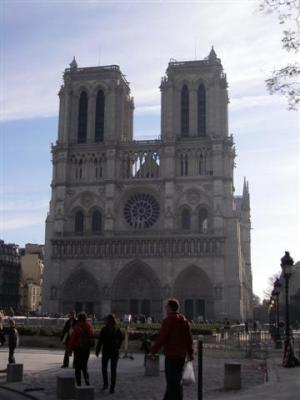
The first thing you notice when you walk in is that the ceilings are really high. The next thing you notice is the large and abundant stained glass windows. They really stand out against the unpainted walls, and it is clear that the stained glass really is the primary artwork. The stained glass, alcoves, balconies and doorways all have interesting shapes that give the interior a lot of structural character, but don’t overwhelm you like the baroque style does. The ceilings are vaulted and the support pillars are substantial in width. The chandeliers are large and eye catching. The floors are a simple black and white checker pattern. Eric was really taken by all the beautiful stained glass. This is one of his favorite churches yet.
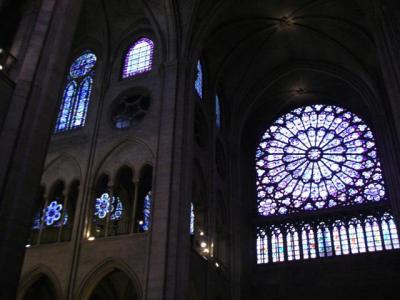
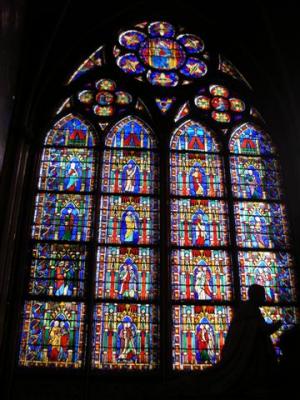
The entire exterior wall is lined with small chapels on all three sides. We walked around and looked at them all. Each chapel is beautiful, and the style of décor varies widely. Some chapels are simply decorated with a stained glass work of art. Others have intricate paintings on the walls and ceiling. Some have reliefs carved into the walls and painted in vibrant colors. Some have sculptures. Some have hanging art. Some have religious accoutrements, like crucifixes and candles that you can light or confessionals. Most have some combination of all the above. The main altar is graced by numerous statues all around the main podium. As is usually the case in churches, the statues are exquisite. The organ is enormous, with 7800 pipes.
There is an adjoining museum you can visit, and you can also go up to the top to get close ups of the sculptures and nice views of the city. We decided to skip both. We mentioned before that museums and churches make us tired. We have figured out why. We have found we only have a limited capacity for how long we can stay at them before our brains get too full and we feel like we can’t absorb anymore. Our next stop is the Louvre, and we can’t wear ourselves out here we need to be as fresh as possible to get the most out of the Louvre.
We walked over to the metro station and took the subway to the Louvre. On a side note, we are impressed with Paris’s subway system. The longest we have waited for a train is three minutes. Almost as soon as one train pulls out, another one pulls in. There are lots of lines and stops, so you can go anywhere you want to quickly and easily.
Anyway, there are two Louvre metro exits. We got off at the first one. We were surprised to see pieces of art on exhibit in the station, which is unlike any other station we have seen so far. All the other stations feature ads for movies and plays. We exited the station to find that we were at the very back of the Louvre, so we walked around to the front. Yesterday, when we said the Louvre was huge, we hadn’t comprehended that there are several more large buildings behind the ones we could see. The building complex is much bigger than we had realized. The buildings we could see yesterday were all in the typical Parisian style, but the ones farther back were in more of a Greco-Roman style, so we are assuming these are the older wings. All the buildings are ornately decorated with statues and other exterior appointments.
One of the things the Louvre is famous for is the unique 21 meter high glass pyramid entranceway that was built relatively recently. From where we had stood yesterday in the Carrousel, we couldn’t really see the pyramid very well. It turns out there are three, the big one flanked by two little ones. The pyramids are in the center of the main courtyard. The pyramids are, in and of themselves, totally modern and cool looking, but they don’t fit at all with the old fashioned buildings that surround them. The effect is that the pyramids are bizarrely out of place.
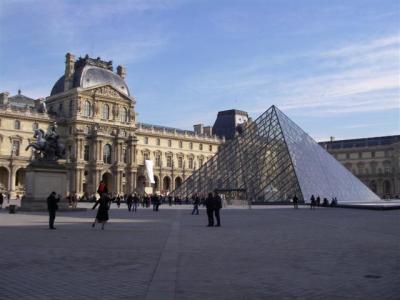
We entered into the pyramid and descended into the brightly lit lobby. We picked up a map and carefully studied it. There are even more buildings that cannot be seen from the street within the complex, all connected by courtyards. This complex is truly massive. When the Louvre first opened, it contained 2500 objects of art. The French government has been steadily assembling the collection and today it is up to 35,000 objects of art on display. It is physically impossible to see everything in the Louvre in one day. It is estimated to take a full 9 months to glance at every piece of art in the museum. To simply walk the entire Louvre in a single day is probably a challenge. So, you have to pick and choose where you want to go. Being as we have a limited capacity for museums, we formed an action plan, prioritizing what we wanted to see and mapping out which exhibits we would pass through to get to the so desired exhibits.
The first thing we did was race off to see “La Joconde”, AKA “The Mona Lisa”. From the entrance we walked through a portion of the Etruscan and Roman Antiquities exhibit. What we saw was mostly sculpture. Many of the sculptures in here use multiple materials. Up until now, pretty much every sculpture we have seen except for one in the Vatican is all made of marble, or all bronze, etc. By using two mediums, such as bronze and marble, you can create the coolest effects. For example, there were some pieces where a person’s body was made of white marble and their clothes were a colored stone. And pieces where the body was bronze and the clothes marble. We enjoyed those a lot.
The Etruscan and Roman Antiquities is actually a huge gallery, but we only made it through a couple of the rooms before arriving at the flight of stairs that would take us up to the Mona Lisa. At the top of the staircase is the famous sculpture “The Winged Victory of Samonthrace”, another sculpture we studied in school.
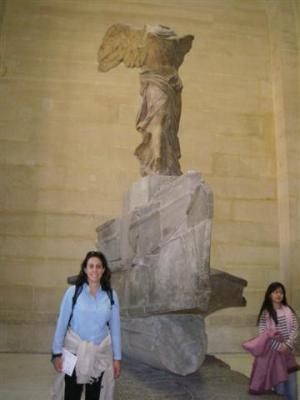
We entered into the wing which houses the 13th to 18th century Italian paintings. We went through several rooms that were opulently decorated, with ceilings that were either painted, carved, gilded, had sculptures, or some combination of all four. The floors are made of colored marble in interesting designs. The rooms are absolutely beautiful — everything you would expect a palace to be. The wall are, of course, plain, to exhibit the paintings.
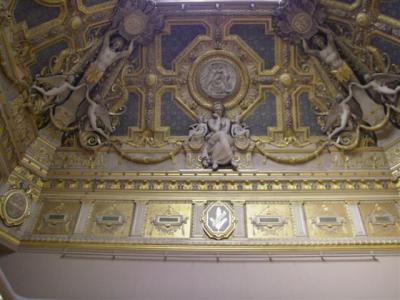
We came to a preposterously long room, and we mean impossibly long for a single room. This room is decorated in the same general style, but has big skylights and floor to ceiling mirrors that make it look even bigger. The room with the Mona Lisa is off the long room. We are happy to report she looks the same in person as it does in all the pictures of it. This is the closest they actually let you get to her.

The same room holds several other works, including the famous “The Wedding Feast at Cana”. From this little room, you could either backtrack back to Italian Paintings or go forward to Large French Paintings. We raced around the French paintings, barely stopping to look at each one. There was a teacher holding class in the French gallery. How cool would it be to go to the museum and study the pieces in person rather than look at them in a slide show like we did? After the French gallery, we went back to Italian paintings. We looked at only about ¼ of the Italian paintings. The room was just too massive and if we looked at them all, we’d be in this room all day.
To be continued”¦
